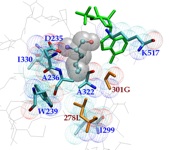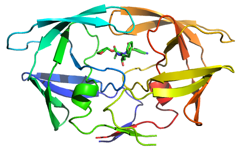 |
 |
 |
| redesigned GrsA-PheA active site | HIV-1 protease + drug | influenza hemagglutinin |
Course description
This course will explore topics in thermodynamics and statistical mechanics of proteins, with a strong emphasis on computation. We will explore what proteins are like as molecules, why understanding their behavior is important and what computational approaches can be used towards this goal.
Prereqs: none. A background in biology, biochemistry or physics is a plus but not required, and the basics will be introduced in context. At the same time, no specific CS courses are required as prereqs, though readings and discussions will often assume familiarity with core concepts (as in CS 5 and 8).
Administrative info
- Instructor
- Gevorg Grigoryan | 113 Sudikoff | office hours: by appointment
- Class meetings
- 2A | TuTh 2:00-3:50 | 115 Sudikoff
- Textbook
- None requited, we'll be reading papers. However, a decent book on thermodynamics of molecules is "Molecular Driving Forces: Statistical Thermodynamics in Chemistry & Biology" by Ken Dill and Sarina Bromberg (see Amazon link).
- Course materials
- Blackboard will be used for submitting critiques. Links to relevant materials will be posted on the reading list page.
Coursework
This seminar course will introduce and study topics by way of primary literature, from seminal papers to results hot off the presses. All students will present papers and participate in discussions; graduate students will also do paper critiques (undergraduates are welcome to, since it's good practice).
- Presentations (50% undergrad; 40% grad)
- Critically present the material in and underlying the
reading, addressing the following:
- The core problem and its context, including why other methods (computational and/or experimental) are insufficient.
- The approach, including how the computational methodology captures and helps address the problem.
- The validation of the approach, including how it is demonstrated to improve the state of the art.
- Strengths and weaknesses of the approach and the paper, and possible next steps.
Help everyone get the big picture and background (since much of the material will be new and challenging), and then provide your insights into the contribution. Try to engage everyone else in a discussion (see class participation below).
The slides and a brief summary are due on blackboard before class.
Follow general advice on how to give a good talk (e.g., by Bruce Donald, Hany Farid, and Simon Peyton-Jones).
I will set up a queue of papers and solicit your preferences for when and what to present. I'm also glad to take your suggestions for specific papers on these topics that you would like to present (or would like to add to the queue). In some cases, additional reading will be required to prepare a presentation; I'm glad to help identify materials.
- Participation (50% undergrad; 40% grad)
- Don't leave the presenter dangling up there! Read the paper(s) thoroughly before class, so that you also can have critical insights into the material. Give your perspectives, ask and respond to questions, raise additional points, etc.
- Critiques (extra credit undergrad; 20% grad)
- For six different papers, not including what you present, write a
short (2-3 paragraph) critique, including the points
discussed above for presentations. Don't just repeat what you read
in the abstract, introduction, and conclusion, but instead use your
own background and experience for a unique critical perspective.
Don't be overwhelmed by jargon and details, but try to cut through
all that to the essence of the contribution.
The critique is due on the blackboard before class.
This is essentially a short review, and there's also plenty of general advice out there for reviewing papers (e.g., by Alan Jay Smith and Ian Parberry).
Honor code
Dartmouth's honor code applies to this course, and academic misconduct policies will be strictly enforced. If you have questions, ask!
As this is a seminar course, you are encouraged and expected to discuss the material with others. You are also encouraged to work in teams for the project. So the only real pitfalls are attribution: the work you present as your own must in fact be your own. In particular, you must write your critiques yourself, in your own words. You must also create your own presentation slides, though you may incorporate others' images and text, with citation. And in your project, while you certainly may use and build upon others' code, you must clearly indicate what part is your contribution.
Disabilities
Students with disabilities enrolled in this course and who may need disability-related classroom accommodations are encouraged to make an appointment to see the instructor before the end of the second week of the term. All discussions will remain confidential, although the Student Accessibility Services office may be consulted to discuss appropriate implementation of any accommodation requested.